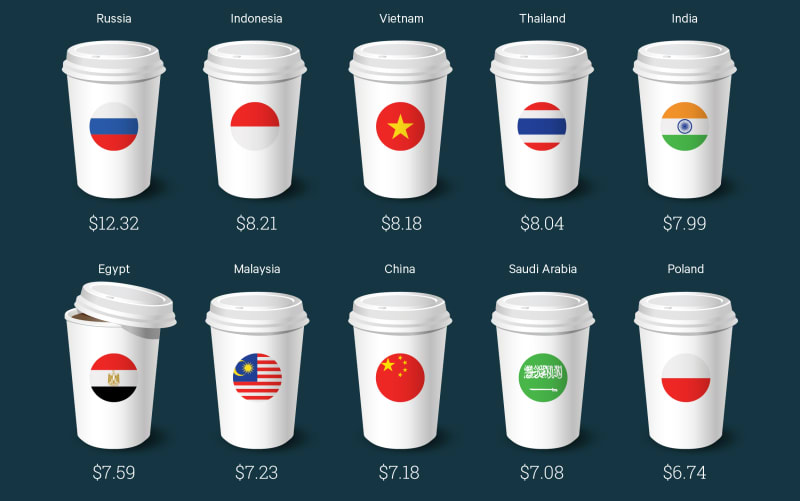Personal Finance
Countries Where Buying Starbucks Is The Most And Least Extravagant

Most coffee drinkers in the U.S. have a sense of how pricey, or not, Starbucks seems. At an average of $2.75 at U.S. Starbucks outlets, a small (or "tall" in Starbucks-speak) hot latte is pricier than a regular cup of joe, even ordered from a coffee shop or restaurant. But it’s less costly than, say, a meal or an alcoholic drink when ordered out.
But how indulgent is Starbucks beyond our borders? To assess that, we took prices for the drink in 39 other countries and adjusted them to reflect the cost of other goods and services there compared with the U.S. (See the methodology below for more on how we generated this data.)
The results reveal that Starbucks is pricier, relatively speaking, in every country outside the U.S. But how much pricier it is varies a lot.
In some countries, a latte hits the wallet only a little harder than in the U.S. The froth-friendly nations include Australia, the U.K., New Zealand, and Canada. Here, Starbucks represents something less than a big indulgence.
But stepping up to the Starbucks counter in the most costly countries feels like a far bigger extravagance. Nothing matches the luxe indulgence of ordering a latte in Russia, where the tab would feel like spending $12 for the drink here at home. In the other pricier countries for Starbucks, including India, Indonesia, and Thailand, the sticker shock would be more akin to spending $7 or so at home.
These seeming splurges underline how inexpensive many other goods and services are in those countries. With bread, milk, or other staples less costly there than in the U.S., Starbucks seems like a big spend indeed. The figures may also explain why in many countries Starbucks is an exotic, status-laden chain--an embodiment, perhaps, of American affluence and indulgence.
Where That Latte Takes The Biggest Bite
This is the price of a tall (as in small) hot latte in U.S. dollars, adjusted to reflect the relative cost of other goods there. As this shows, Starbucks is a luxe indulgence in these places, costing as much or more as a simple lunch out.

Where A Cup's Only A Little More Indulgent Than In The U.S.
This is the price of a tall (small) hot latte in U.S. dollars, adjusted to reflect the relative cost of other goods there. As this shows, Starbucks is a little more of an indulgence in these places than in the U.S., but still isn't a luxury splurge.

Where Starbucks Is Most To Least Costly, Relatively Speaking
Country | Comparative Cost, Starbucks Tall Latte |
|---|---|
| Russia | $12.32 |
| Indonesia | $8.21 |
| Vietnam | $8.18 |
| Thailand | $8.04 |
| India | $7.99 |
| Egypt | $7.59 |
| Malaysia | $7.23 |
| China | $7.18 |
| Saudi Arabia | $7.08 |
| Poland | $6.74 |
| Philippines | $6.45 |
| Bulgaria | $6.37 |
Methodology
We analysed the most recent market data (from January 2016) on the cost of a small ("tall") hot latte at Starbucks in 44 countries around the world, as gathered by Euromonitor International, a leading global provider of market research. In countries for which there were multiple price quotes, we averaged the quotes to arrive at a national average.
While the gathered data was in the local currency of each nation, we didn’t simply convert the currency into U.S. dollars, because such a conversion would not reflect the differing purchasing power of a certain amount of money in each country. Instead, we used a converter developed by a consultant, Nigel Babu, that uses data from the World Bank that reflects the respective cost of a basket of goods, including food, in countries around the world. The dollar figure we show, then, represents the cost of that latte in context with other goods.
In all countries, the relative cost of that Starbucks cup was higher than in the U.S., but there was variation in how much higher it was. The figure we show, then, essentially represents the sticker shock, from mild to major, that you’d feel if you lived in the country, making a local salary, and perused the prices at one of the local Starbucks. Put another way, it’s how pricey that drink would seem to a local latte drinker, in light of what most things cost in the country.
